1. Arm Tai Yin Lung Meridian
Symptoms:
Disorders of the Lung Meridian lead to diseases related to TCM lung dysfunction. According to TCM, the lung rules and regulates qi throughout the body and administers respiration (breathing). In addition, the lung moves and adjusts the water channels, so disorders of this meridian may be related to disharmony of lung fluid or "water" and respiratory disorders. Symptoms like chest discomfort with a fullness sensation, dyspnea (shortness of breath), cough, and wheezing indicate Lung Meridian disharmony. This disharmony can also lead to pain along the meridian position. For example, a person may feel pain in the shoulder and back or along the anterior border of the medial aspect of the arm.
Main indications:
Acupuncture points in the Lung Meridian are indicated for throat, chest and lung ailments and for other symptoms that are presented along the meridian's pathway.
2. Arm Yang Ming Large Intestine Meridian
Symptoms:
Disharmony of the Large Intestine Meridian can lead to symptoms of abdominal pain, intestinal cramping, diarrhea, constipation and dysentery. Since it passes through the oral cavity and the nose, symptoms like toothache, a runny nose, nosebleeds, and pain or heat along the meridian pathway can also indicate a disorder in this meridian.
Main indications:
Acupuncture points in this meridian are indicated for diseases affecting the head, face, pharynx (throat), febrile conditions and other symptoms along the meridian pathway.
3. Leg Yang Ming Stomach Meridian
Symptoms:
Stomach Meridian disorders have symptoms of stomachache, rapid digestion, hunger, nausea and vomiting, or thirst. Other symptoms that relate to disorders along the meridian pathway include abdominal distension, ascites (a fluid build up in the abdomen), sore throat, nosebleeds, or pain in the chest or knee.
Main indications:
Acupuncture points in this meridian are indicated for certain gastro enteric diseases, toothaches and mental illnesses. Conditions that affect areas through which the meridian passes such as the head, face, eyes, nose and mouth can also benefit from stimulation of the acupuncture points along this meridian.
4. Leg Tai Yin Spleen Meridian
Symptoms:
Disharmony of the Spleen Meridian is related to spleen dysfunction. According to TCM, the spleen is responsible for the transformation and transportation of different substances, and is the foundation of our after-birth existence. Spleen function is essential in maintaining the digestive power of the body and transforming food into qi and blood. If the Spleen Meridian does not function properly, qi cannot be efficiently transported to the spleen. As a result, symptoms like abdominal distention, loose stools, diarrhea, epigastric pain, flatulence and a heavy sensation in the body occur. In addition, symptoms such as pain at the root of the tongue, swelling of the inner side of the lower limb may also indicate disharmony of the Spleen Meridian.
Main indications:
Acupuncture points in this meridian are indicated for peptic, gynecological and genital diseases. They are also indicated for symptoms along the meridian.
5. Arm Shao Yin Heart Meridian
Symptoms:
Disharmony of the Heart Meridian leads to pain at the heart position (precordial pain or pain at the sternum). In TCM, the heart rules the blood and the pulse. Without sufficient nourishment, an individual may feel thirsty and have a dry throat. Pain in the inner side of the forearm and heat in the palm may also indicate problems in this meridian.
Main indications:
Acupuncture points in this meridian are indicated for heart, chest and mental problems. They are also indicated for symptoms along the meridian.
6. Arm Tai Yang Small Intestine Meridian
Symptoms:
Disharmony of the Small Intestine Meridian presents mainly as symptoms along its pathway such as a swollen chin, stiff neck, sore throat, hearing problems, yellow eyes, and pain along the shoulder, upper arm, elbow and forearm.
Main indications:
Acupuncture points in this meridian are indicated for diseases of the head, neck, ear, eyes and pharynx (throat), as well as certain febrile conditions and mental illnesses. These acupuncture points are also recommended for symptoms associated with the meridian's pathway.
7. Leg Tai Yang Bladder Meridian
Symptoms:
Disharmony of the Bladder Meridian can lead to problems of TCM bladder dysfunction. It is often related to symptoms caused by external pernicious influences (outside influences that cause disease such as cold, wind, fire, dampness, dryness and summer heat). Because the Tai Yang Meridian is considered the most exterior, it is the first meridian to be invaded if there is any external attack. Therefore, its disharmony can cause symptoms such as difficult urination, incontinence, painful eyes, runny nose, nose bleeding and nasal congestion. Pain in the head, neck, back, groin and buttock areas indicate disharmony in the Bladder Meridian pathway.
Main indications:
Acupuncture points in this meridian are indicated for diseases in the head, neck, eyes, back, groin and lower limbs as well as certain and mental illnesses. They are also recommended for symptoms along the meridian pathway.
8. Leg Shao Yin Kidney Meridian
Symptoms:
Disharmony of Kidney Meridian can manifest as wheezing or coughing because the kidneys "grasp the qi". They also are the "mansion of fire and water," and the "residence of yin and yang". If there is insufficient nourishment and warming of the kidney, symptoms like edema (swelling), constipation, and diarrhea can indicate an imbalance in this meridian. Pain in the groin and pharynx (throat), which are located along the meridian's pathway, also can indicate a problem with the Kidney Meridian.
Main indications:
Acupuncture points in this meridian are used for gynecological, genital, kidney, lung, and pharynx (throat) diseases. They are also indicated for symptoms associated with the pathway of the meridian.
9. Arm Jue Yin Pericardium Meridian
Symptoms:
Disharmony of the Pericardium Meridian is related to the imbalance of the TCM heart and blood functions. The manifestation includes heart pain (precordial pain), chest discomfort, palpitations and an oppressed feeling in the chest. Since the Heart stores the "shen" or mental activities, Pericardium Meridian disorders are related to mania. In addition, swelling of the axilla and spasms of the elbow and arm can indicate a problem in this meridian, since it passes through these areas.
Main indications:
Acupuncture points in this meridian are used for heart, chest, and peptic diseases as well as mental illness. They are also indicated for symptoms manifested along the meridian's pathway.
10. Arm Shao Yang Triple Burner Meridian
Symptoms:
Disharmony of the Triple Burner Meridian leads to symptoms like abdominal distention, edema (swelling), urinary incontinence, difficulty urinating, loss of hearing, and ringing in the ears (tinnitus). Pain in the pharynx (throat), eyes, cheek, back of the ear, shoulder and the upper arm can occur as these structures are located along this meridian's pathway.
Main indications:
Acupuncture points in this meridian are recommended for ailments of the ears, eyes, chest, pharynx (throat), and the side of the head as well as certain febrile conditions. They are also indicated for symptoms along this meridian's pathway.
11. Leg Shao Yang Gall Bladder Meridian
Symptoms:
In TCM, the gall bladder is closely related to the liver. Hence, the disharmony of the Gall Bladder Meridian causes symptoms such as a bitter taste in the mouth, dizziness, headache, and pain at the outer angle of the eyelids. Pain along the meridian pathway such as in the axilla (armpit), chest, lower chest, buttocks and the lateral side of the lower limbs can also indicate a disorder of the Gall Bladder Meridian.
Main indications:
Acupuncture points in this meridian are indicated for ailments of the eyes, ears, pharynx (throat), and lateral side of the head in addition to mental illness and fever. They are also recommended for symptoms along the meridian's pathway.
12. Leg Jue Yin Liver Meridian
Symptoms:
Disharmony of the Liver Meridian leads to groin pain, chest fullness, urinary incontinence, difficulty urinating, swelling of the lower abdomen and hernias.
Main indications:
Acupuncture points in this meridian are indicated for liver, gynecological and genital diseases. They are also recommended for symptoms along the meridian's pathway.
| Pathway: The Lung Meridian originates in the middle portion of the body, and runs downwards connecting with the large intestine. It then turns and passes through the diaphragm to connect with the lungs. This meridian branches out from the axilla (armpit) and runs down the medial aspect of the upper arm where it crosses the elbow crease. It continues until it passes above the major artery of the wrist, and emerges at the tip of the thumb. Another branch emerges from the back of the wrist and ends at the radial side of the tip of the index finger to connect with the Large Intestine Meridian. | 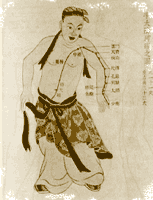 |
Disorders of the Lung Meridian lead to diseases related to TCM lung dysfunction. According to TCM, the lung rules and regulates qi throughout the body and administers respiration (breathing). In addition, the lung moves and adjusts the water channels, so disorders of this meridian may be related to disharmony of lung fluid or "water" and respiratory disorders. Symptoms like chest discomfort with a fullness sensation, dyspnea (shortness of breath), cough, and wheezing indicate Lung Meridian disharmony. This disharmony can also lead to pain along the meridian position. For example, a person may feel pain in the shoulder and back or along the anterior border of the medial aspect of the arm.
Main indications:
Acupuncture points in the Lung Meridian are indicated for throat, chest and lung ailments and for other symptoms that are presented along the meridian's pathway.
2. Arm Yang Ming Large Intestine Meridian
| Pathway: The Large Intestine Meridian starts from the tip of the index finger and runs between the thumb and the index finger. It then proceeds along the lateral side of the forearm and the anterior side of the upper arm, until it reaches the highest point of the shoulder. From there, it has two branches. One goes internally towards the lungs, diaphragm and large intestine. The other travels externally upwards where it passes the neck and cheek, and enters the lower teeth and gums. It then curves around the upper lip and crosses to the opposite side of the nose. | 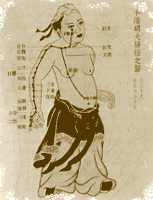 |
Disharmony of the Large Intestine Meridian can lead to symptoms of abdominal pain, intestinal cramping, diarrhea, constipation and dysentery. Since it passes through the oral cavity and the nose, symptoms like toothache, a runny nose, nosebleeds, and pain or heat along the meridian pathway can also indicate a disorder in this meridian.
Main indications:
Acupuncture points in this meridian are indicated for diseases affecting the head, face, pharynx (throat), febrile conditions and other symptoms along the meridian pathway.
3. Leg Yang Ming Stomach Meridian
| Pathway: The Stomach Meridian starts from the end of the Large Intestine Meridian at the side of the nose, and passes through the inner corner of the eye to emerge from the lower part of the eye. Going downwards, it enters the upper gum and curves around the lips and lower jaw. It then turns upwards, passing in front of the ear, until it reaches the corner of the forehead where it splits into an internal and external branch. The internal branch emerges from the lower jaw, running downwards until it reaches its pertaining organ, the stomach. The external branch crosses the neck, chest, abdomen and groin where it goes further downward along the front of the thigh and the lower leg, until it reaches the top of the foot. Finally, it terminates at the lateral side of the tip of second toe. Another branch emerges from the top of the foot and ends at the big toe to connect with the Spleen Meridian. | 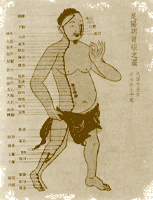 |
Stomach Meridian disorders have symptoms of stomachache, rapid digestion, hunger, nausea and vomiting, or thirst. Other symptoms that relate to disorders along the meridian pathway include abdominal distension, ascites (a fluid build up in the abdomen), sore throat, nosebleeds, or pain in the chest or knee.
Main indications:
Acupuncture points in this meridian are indicated for certain gastro enteric diseases, toothaches and mental illnesses. Conditions that affect areas through which the meridian passes such as the head, face, eyes, nose and mouth can also benefit from stimulation of the acupuncture points along this meridian.
4. Leg Tai Yin Spleen Meridian
| Pathway: The Spleen Meridian begins at the big toe and runs along the inside of the foot crossing the inner ankle. It then travels along the inner side of the lower leg and thigh. Once it enters the abdominal cavity, it internally connects with the spleen and continues upward to reach the Heart Meridian. Externally, the Spleen Meridian continues moving toward the chest and branches out to reach the throat and the root of the tongue. | 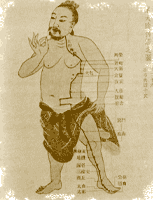 |
Disharmony of the Spleen Meridian is related to spleen dysfunction. According to TCM, the spleen is responsible for the transformation and transportation of different substances, and is the foundation of our after-birth existence. Spleen function is essential in maintaining the digestive power of the body and transforming food into qi and blood. If the Spleen Meridian does not function properly, qi cannot be efficiently transported to the spleen. As a result, symptoms like abdominal distention, loose stools, diarrhea, epigastric pain, flatulence and a heavy sensation in the body occur. In addition, symptoms such as pain at the root of the tongue, swelling of the inner side of the lower limb may also indicate disharmony of the Spleen Meridian.
Main indications:
Acupuncture points in this meridian are indicated for peptic, gynecological and genital diseases. They are also indicated for symptoms along the meridian.
5. Arm Shao Yin Heart Meridian
| Pathway: The Heart Meridian starts from the heart, and divides into three branches. One goes towards the small intestine. The second runs upwards along the throat towards the eyes, and the third branch emerges under the arm and runs along the inner side of the forearm, elbow and upper arm. It then crosses the inner side of the wrist and palm and ends at the inside tip of the little finger, where it connects with the Small Intestine Meridian. | 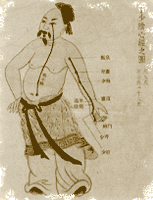 |
Disharmony of the Heart Meridian leads to pain at the heart position (precordial pain or pain at the sternum). In TCM, the heart rules the blood and the pulse. Without sufficient nourishment, an individual may feel thirsty and have a dry throat. Pain in the inner side of the forearm and heat in the palm may also indicate problems in this meridian.
Main indications:
Acupuncture points in this meridian are indicated for heart, chest and mental problems. They are also indicated for symptoms along the meridian.
6. Arm Tai Yang Small Intestine Meridian
| Pathway: The Small Intestine Meridian starts from the tip of the little finger and crosses the palm and wrist. It runs upwards along the posterior side of the forearm until it reaches the back of shoulder where it ends at the uppermost part of the back (the bottom of the neck). At this position, it first branches off and moves internally through the heart and stomach to reach the small intestine. The second branch travels externally across the neck and cheek until it reaches the outer corner of the eye and then enters the ear. A short branch in the cheek moves upward to the inner corner of the eye where it connects with the Bladder Meridian. | 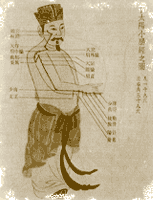 |
Disharmony of the Small Intestine Meridian presents mainly as symptoms along its pathway such as a swollen chin, stiff neck, sore throat, hearing problems, yellow eyes, and pain along the shoulder, upper arm, elbow and forearm.
Main indications:
Acupuncture points in this meridian are indicated for diseases of the head, neck, ear, eyes and pharynx (throat), as well as certain febrile conditions and mental illnesses. These acupuncture points are also recommended for symptoms associated with the meridian's pathway.
7. Leg Tai Yang Bladder Meridian
| Pathway: The Bladder Meridian starts at the inner side of the eye and goes across the forehead to reach the top of the head where it branches into the brain. The main channel then goes across the back of the head and divides into two branches. One branch crosses the center of the base of the neck and extends downwards parallel to the spine. Once in the lumbar region (bottom of the spine), it branches out to reach the bladder. The other branch crosses the back of the shoulder and runs downward on the outside, which is adjacent and parallel to the inner branch. It continues down until it reaches the buttocks where two branches run across the back of thigh along different pathways that join at the back of the knee. The joint meridian then continues along the back of the lower leg, circles behind the outer ankle, runs along the outside of the foot and terminates on the lateral side of the tip of the small toe, where it connects with the Kidney Meridian. | 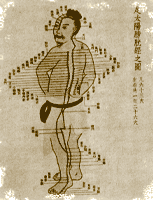 |
Disharmony of the Bladder Meridian can lead to problems of TCM bladder dysfunction. It is often related to symptoms caused by external pernicious influences (outside influences that cause disease such as cold, wind, fire, dampness, dryness and summer heat). Because the Tai Yang Meridian is considered the most exterior, it is the first meridian to be invaded if there is any external attack. Therefore, its disharmony can cause symptoms such as difficult urination, incontinence, painful eyes, runny nose, nose bleeding and nasal congestion. Pain in the head, neck, back, groin and buttock areas indicate disharmony in the Bladder Meridian pathway.
Main indications:
Acupuncture points in this meridian are indicated for diseases in the head, neck, eyes, back, groin and lower limbs as well as certain and mental illnesses. They are also recommended for symptoms along the meridian pathway.
8. Leg Shao Yin Kidney Meridian
| Pathway: The Kidney Meridian starts from the inferior side of the small toe. Crossing the middle of the sole and the arch of the foot, it circles behind the inner ankle and travels along the innermost side of the lower leg and thigh, until it enters the body near the base of the backbone. After connecting with the kidney, it comes out at the pubic bone. Over the abdomen, it runs externally upwards until it reaches the upper part of the chest (the inner side of clavicle). A second branch emerges from the kidney and moves internally upwards and passes through the liver, diaphragm, lungs and throat, finally terminating at the root of the tongue. Another small branch divides from the lung to connect with the heart and the pericardium. | 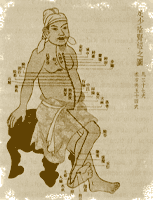 |
Disharmony of Kidney Meridian can manifest as wheezing or coughing because the kidneys "grasp the qi". They also are the "mansion of fire and water," and the "residence of yin and yang". If there is insufficient nourishment and warming of the kidney, symptoms like edema (swelling), constipation, and diarrhea can indicate an imbalance in this meridian. Pain in the groin and pharynx (throat), which are located along the meridian's pathway, also can indicate a problem with the Kidney Meridian.
Main indications:
Acupuncture points in this meridian are used for gynecological, genital, kidney, lung, and pharynx (throat) diseases. They are also indicated for symptoms associated with the pathway of the meridian.
9. Arm Jue Yin Pericardium Meridian
| Pathway: The Pericardium Meridian starts from the chest, leaves the pericardium organ and runs downwards through the diaphragm to connect with the triple burner. A branch rising from the chest emerges from the lower chest region and travels upwards to the axilla (armpit). From the medial aspect of the upper arm, it makes its way down between the lung and heart channels, until it reaches the elbow crease. It then runs down the forearm and enters the palm ending at the tip of the middle finger. Another short branch splits off from the palm to connect with the Triple Burner Meridian at the end of the ring finger. | 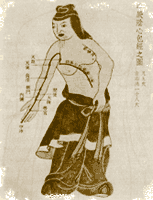 |
Disharmony of the Pericardium Meridian is related to the imbalance of the TCM heart and blood functions. The manifestation includes heart pain (precordial pain), chest discomfort, palpitations and an oppressed feeling in the chest. Since the Heart stores the "shen" or mental activities, Pericardium Meridian disorders are related to mania. In addition, swelling of the axilla and spasms of the elbow and arm can indicate a problem in this meridian, since it passes through these areas.
Main indications:
Acupuncture points in this meridian are used for heart, chest, and peptic diseases as well as mental illness. They are also indicated for symptoms manifested along the meridian's pathway.
10. Arm Shao Yang Triple Burner Meridian
| Pathway: The Triple Burner Meridian begins at the outer tip of the ring finger and goes along the back of the hand, wrist, forearm and upper arm, until it reaches the shoulder region where it branches off. One branch travels internally into the chest and passes through the pericardium and diaphragm uniting the upper, middle and lower burner (triple burner). The other branch runs externally up the side of the neck, circles the ear and face, and finally ends at the outer end of the eyebrow where it connects with the Gall Bladder Meridian. | 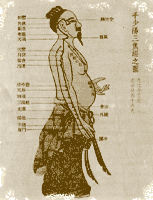 |
Disharmony of the Triple Burner Meridian leads to symptoms like abdominal distention, edema (swelling), urinary incontinence, difficulty urinating, loss of hearing, and ringing in the ears (tinnitus). Pain in the pharynx (throat), eyes, cheek, back of the ear, shoulder and the upper arm can occur as these structures are located along this meridian's pathway.
Main indications:
Acupuncture points in this meridian are recommended for ailments of the ears, eyes, chest, pharynx (throat), and the side of the head as well as certain febrile conditions. They are also indicated for symptoms along this meridian's pathway.
11. Leg Shao Yang Gall Bladder Meridian
| Pathway: The Gall Bladder Meridian starts from the outer corner of the eye and divides into two branches. One branch runs externally and weaves back and forth at the lateral side of the head. After curving behind the ear, it reaches the top of the shoulder and crosses the lateral side of rib cage and abdomen, until it ends up at the side of the hip. The other branch enters the cheek and runs internally downward, through the neck and chest to connect with the gall bladder. It continues moving downwards and comes out in the lower abdomen, where it connects with the other branch at the hip. The hip branch then runs toward the lateral side of the thigh and lower leg. After crossing the ankle, it goes over the foot to reach to the tip of the fourth toe. Another small branch leaves the meridian and terminates at the big toe to connect with the Liver Meridian. | 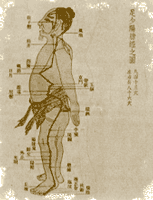 |
In TCM, the gall bladder is closely related to the liver. Hence, the disharmony of the Gall Bladder Meridian causes symptoms such as a bitter taste in the mouth, dizziness, headache, and pain at the outer angle of the eyelids. Pain along the meridian pathway such as in the axilla (armpit), chest, lower chest, buttocks and the lateral side of the lower limbs can also indicate a disorder of the Gall Bladder Meridian.
Main indications:
Acupuncture points in this meridian are indicated for ailments of the eyes, ears, pharynx (throat), and lateral side of the head in addition to mental illness and fever. They are also recommended for symptoms along the meridian's pathway.
12. Leg Jue Yin Liver Meridian
| Pathway: The Liver Meridian starts from the top of the big toe and goes across the top of the foot. After crossing the inner ankle, it continues to go upwards along the inner side of the lower leg and the thigh, until it reaches the pubic region. It then circulates around the external genitalia and enters the lower abdomen. Afterwards, it goes up the abdomen and reaches the lower chest to connect with the liver and gall bladder. The meridian further travels upwards along the throat and connects with the eyes. Finally it emerges from the forehead to reach the vertex of the head. One of its internal branches originates internally from the eye and moves downwards to the cheek where it curves around the inner surface of the lips. Another branch starts from the liver and passes through the diaphragm to reach the lung where it connects with the Lung Meridian and completes the cycle of the twelve meridians. | 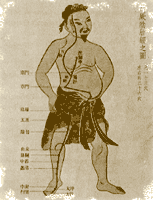 |
Disharmony of the Liver Meridian leads to groin pain, chest fullness, urinary incontinence, difficulty urinating, swelling of the lower abdomen and hernias.
Main indications:
Acupuncture points in this meridian are indicated for liver, gynecological and genital diseases. They are also recommended for symptoms along the meridian's pathway.







No comments:
Post a Comment